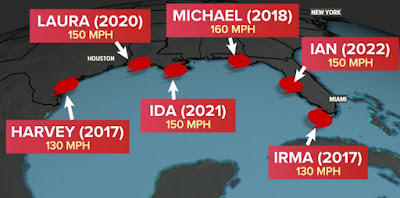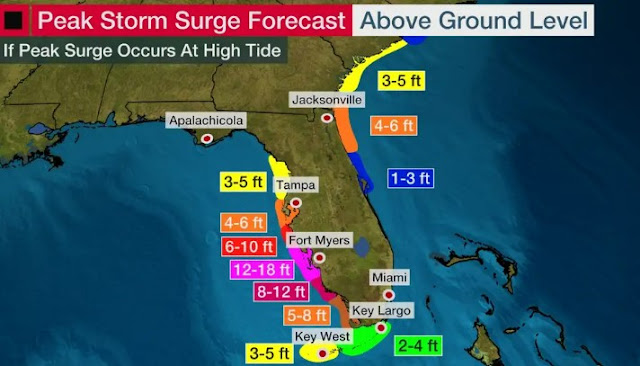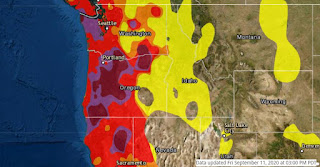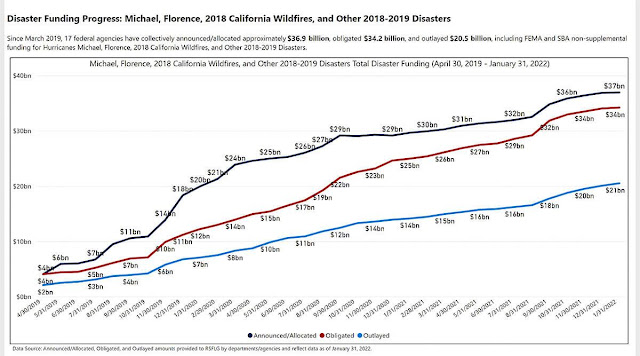Streets of downtown in Fort Myers get flooded due to the surge of the Caloosahatchee River as Hurricane Ian hit the West Coast of Florida as a Category 4 storm, on Wednesday, Sept. 28, 2022. Drowning has emerged as the top cause of death from the storm.
Hurricane Ian Map with Wind Speeds
Fort Myers Beach is Under Water & Houses Floating Away
Currently in Fort Myers, Florida. Video by Loni Architects #flwx #Ian #hurricane pic.twitter.com/8nfncFlG9G
— Kaitlin Wright (@wxkaitlin) September 28, 2022
Houses are destroyed and some are floating away as Ian's eyewall hammers southwest Florida. This is video from Fort Myers Beach, Florida off Estero Blvd by Loni Architects
*RARE* first person view of storm surge. This camera is 6 feet off the ground on Estero Blvd in Fort Myers Beach, FL. Not sure how much longer it keeps working. You’ll see it live only on @weatherchannel #Ian pic.twitter.com/WwHtvgVxjY
— Mike Bettes (@mikebettes) September 28, 2022
Storm Surge Maps Hurricane Ian in Fort Myers & Coral Cay, Florida
 NOAA Hurricane Storm Surge Map
NOAA Hurricane Storm Surge Map
Potential Storm Surge Flooding Map in Fort Myers and Cape Coral
Areas greater than 1-9 feet above the ground near the ocean
For more information on previous hurricanes in Florida see this link.
Florida Income Map of Red Cross, Salvation Army, Food Pantries & Shelters #hurricaneian https://t.co/dGBvIsnVgu pic.twitter.com/sPApVY3Zfe
— Disaster Relief Maps (@disastermapping) September 28, 2022
Portland Air Quality Map
Marine air begins to work inland over the next couple of days with a modest westerly breeze. This will allow air quality and visibilities to begin to improve over northwest OR and southwest WA, as seen in this computer model for today (Fri). Purples depict the densest smoke. pic.twitter.com/U7ADxX4smw
— NWS Portland (@NWSPortland) September 11, 2020
Essay on California Wildfires
A wildfire is a destructive and uncontrollable fire that burns down the forest. Wildland fires erupt worldwide in different seasons and are caused by various issues. Even though fires can be beneficial, uncontrolled occurrences have proved harmful to both people and the environment. Examples of countries that have been victims include South Africa, Brazil, and Canada. Like all these, California has written its history based on the numerous forest fires that have been occurring, putting the country at risk of losing all its natural heritage. 2007, 2008, 2017, 2018, and 2020 have been the toughest on California as the country has witnessed some of the largest fires in history, losing more than 100,000ha of land (Keeley & Syphard, 2021). These occurrences continue to affect California in many ways regarding environmental degradation. Thus, this essay on California wildfires seeks to present the issue of wildfires in the country and focuses on establishing the history of the fires, their mechanisms, and the possible methods that can be used to prevent them.
History of California Wildfires
According to the
California Department of Forestry and Fire Protection (CAL FIRE), the country
has witnessed more than 10,000 incidents of wildfires. Incidentally, the
statistical records held by the agency from the time of its inception, which is
1932, allude to an exponential increase in the number of forest fires over an
80-year timeline. Almost all the fire scenarios have consumed hundreds of
hectares of land forests, leaving the country to deal with severe cases of
environmental damage. The most significant case to have been recorded in the
history of California is the 2020 August Complex Fire. In this incident, 38
separate fires, which have since been classified as one, ravaged over 418,000ha
(Keeley & Syphard, 2021). The same scenario was witnessed with the LNU
complex fire, even though it did not result in a merger. However, the results
of their occurrences have forced the citizens to live with the repercussions of
environmental and property damage.
California’s
cases of wildfires call for the initiation of research studies, especially in
identifying the probable root causes. According to Li & Banerjee (2021),
California has been experiencing wildfires for more than 80 years.
Surprisingly, only 1% of the reported instances can be considered large fires.
However, this does not rubbish the fact that all the cases have contributed to
the loss of property and lives. Hence, the quest to establish real causal
factors remains, and all government agencies and citizens must work together to
ensure they are curtailed. Keeley & Syphard (2021) claims that most forest
fires can be linked to rapid changes in climate. Perhaps this argument might
hold some ground. However, whether the variations have been constant for the
entire period remains a mystery, as notable changes in the size of the forest
fires have been seen in the last decade. In contrast, California has had to
battle wildfires since the early 1900s. Thus, more critical research studies
deserve to be conducted to ensure the findings being presented to the public
are accurate and a true reflection of the state of the country’s situation.
Mechanism
California’s woes
with wildfires demand that we understand two fundamental mechanisms, which
perhaps have been vital in the ignition and propagation of the fires. First,
CAL FIRE’s research holds that human factors play a significant role in the
occurrence of wildfires, starting in more than 95% of the cases. These factors
include unchecked or improperly put-out campfires, cigarette butts, and in some
cases, arson. A sample case of arson is the 2003 Old fire, which the
pyromaniacs started, which led to the destruction of large forest reserves
(Keeley & Syphard, 2021). Such occurrences, among other human causes, have
contributed to the massive destruction of the forested land. Despite the
statistical proof that human factors have been the primary cause, it is also
evident that some natural causes have played a role in the number of wildfires
in the country. For example, the McDonald fire, which consumed more than 1000ha
of land in Lassen County, was started by light. Thus, the larger cause must be
curtailed to bring about a reduction in the incidences.
Another mechanism
worth exploring is the propagation of fires. According to Li & Banerjee
(2021), climate change is the primary promoter of forest fires. Specifically,
California has been witnessing many dry conditions, with the strength of wind
continuing to increase each passing day. As a result, any slight occurrence of
fire, whether small or large, is easily propagated. The Diablo and Santa Ana
winds are the greatest culprits in this case, especially since they play a role
in stroking the fires, leading to more damage. These scenarios communicate the
urgency with which the government must act to ensure proper climate
intervention measures are implemented, specifically to ensure forest fires are
minimized.
Prevention and Mitigation
California’s
wildfires have proved to be a nuisance to the environment, endangering the
people’s health and putting the country’s economy at risk. However, developing
the most workable solutions is impossible without in-depth research into the
issues. Li & Banerjee (2021) have attempted to focus on this aspect, presenting
an elaborate statistical analysis of the causes of wildfires from a sample of
century-long occurrences. The results show that climate change has been
responsible for most large fires, giving the government a chance to leverage a
targeted approach to the issue. In essence, the numerous reports published by
CAL FIRE can complement the study’s recommendations to ensure a workable
solution is obtained.
Most wildfires
start due to human negligence. Therefore, California’s government has come up
with a multi-agency team to conduct extensive monitoring and inspection of the
environment to ensure all the possible causes of wildfires are thwarted. Also,
there has been mass sensitization of the public to ensure that people can
understand the implications of their actions on the environment, especially
concerning the continuous occurrence of fires.
Ultimately, CAL
FIRE, in collaboration with various other teams, including the Forest
Management Taskforce, has come up with environmental conservation programs. The
programs have involved the removal of dead tree remains and the clearing of
bushes. Even though these measures may appear minimal, the impacts are pretty
noticeable, specifically when it is considered that these dry materials and
light bushes have been contributing to the rapid propagation of wildfires.
Hopefully, these measures will contribute to reducing the fires and allow the
citizens to reclaim the lost glory.
Conclusion
This essay on
California wildfires presents the issue as a critical part of history, especially
when it is considered that the country has had to battle them for more than
eight decades. The fires are caused by human factors and are fueled by the
rapidly changing climate. Therefore, proper control of the situation demands
that CAL FIRE develop procedures to eliminate the root causes and implement
strict management measures.
Are you
interested in getting a customized essay like the one above? You might want to
consider ordering them from the following essay writing service CustomWritings.com.
The company has professional academic writers who can write your research
papers and homework assignments from scratch. You can consider placing your
order with them as the prices are affordable.
References
Keeley, J. E., & Syphard, A. D. (2021).
Large California wildfires: 2020 fires in historical context. Fire Ecology, 17(1), 1-11. https://doi.org/10.1186/s42408-021-00110-7
Li, S., & Banerjee, T. (2021). Spatial and
temporal pattern of wildfires in California from 2000 to 2019. Scientific Reports, 11(1), 1-17. https://doi.org/10.1038/s41598-021-88131-9
Disaster Relief ETF (FEMA) Launches for Hurricane Season
The Atlantic hurricane season is in full swing, and a new exchange-traded fund that focuses on disaster recovery has launched just in time for it.
What is Disaster Relief & How Does Funding Work?
Disaster relief is money paid out to those suffering as a result of natural (or man-made) disasters. 'Natural disasters' can mean lots of different things. To be clear, we're not talking about run-of-the-mill weather events like snowstorms or hurricanes, but catastrophes such as earthquakes and volcanic explosions.
Map of Natural Disasters Around the World Since 1900
Popular Maps
-
Public Perception Maps vs Actual Lava Flow on Hawaii Big Island Hawaii VOG Map If you are planning to vacation or li...
-
Both the CalWood and Lefthand Canyon fires increased containment on Wednesday with minimal fire growth. The CalWood Fire is now 24% containe...
-
Huge storms produced widespread hurricane-like severe wind damage across Iowa, northern Illinois, and northern Indiana during the day o...
-
Colorado Current Wildfire Maps Colorado wildfires in Pine Gulch, Grizzly Creek, Cameron Peak, Williams Fork, Lewiston, and Thorpe
-
For each county above, you can check out interactive maps, evacuation orders, alerts, and school closures: As the Glass Fire continues to ex...
-
According to Sheriff Eric Magrini, three people have died due to the Zogg Fire in Shasta County. Magrini gave no further information about...






















